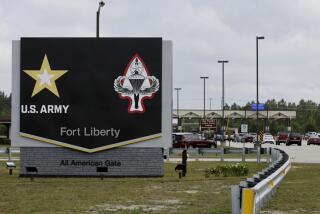Base tracks its CO2 ‘bootprint’
- Share via
FT. CARSON, COLO. — Soldiers here fired off 12 million pieces of mortar, rifle and artillery ammunition on the training range last year, exercises the Army now knows generated 58.8 tons of carbon dioxide.
This post south of Colorado Springs is the first in the Army to begin tracking greenhouse gases emitted by its barracks, tanks and training activities. The next step: cutting emissions by nearly a third.
“What we’re doing at Ft. Carson is the first deliberate effort to calculate our carbon ‘bootprint’ and do it in a way that’s based on real data,” said Tad Davis, deputy assistant secretary of the Army for environment, safety and occupational health. “We’re trying to be as precise as we can.”
The effort is in response to a 2007 order by President Bush that the Department of Defense reduce all carbon emissions by 30% over the next seven years.
If the new system is successful at Ft. Carson, it could expand to other Army bases, starting with Ft. Benning in Georgia. “We need to make sure the system is adaptable Army-wide,” Davis said.
Few companies or cities can do what the Army post now is capable of, said Lawrence Goldenhersh, president and chief executive of Enviance, a California-based company that created the tracking system for Ft. Carson. Enviance provides Internet-based systems to help companies comply with state and federal environmental regulations by tracking emissions.
“I see this as an example of the Army leading the nation,” Goldenhersh said. “You can’t reduce it if you can’t see it.”
This year, the mountain post, home to 18,500 troops, got the first glimpse of its impact: 200,000 tons of carbon emissions last year. That’s the equivalent of a city of 25,000 or annual emissions from about 37,000 vehicles, Goldenhersh said. How the base will go about cutting its emissions remains to be seen.
At Ft. Carson, about half the emissions come from vehicles -- government and privately owned vehicles -- and the other half comes from facilities, said Chad Meister, a contract air program coordinator. He calculated that the output on the artillery range last year was the equivalent of driving a standard sedan 142,000 miles.
Over the last several years, Ft. Carson has taken steps to make its facilities more energy-efficient. It has remodeled old barracks using “green” building methods and recycles construction materials and rubble. The post obtains 2% of its energy from a 12-acre solar array built atop an old landfill, and nearly half of administrative cars at the base run on alternative fuels.
Army officials also are considering ways to encourage less driving, such as carpooling and telecommuting for some workers, Davis said.
But the military fleet of tanks, Humvees and other vehicles poses a particular challenge, and it will be difficult for the Army to reduce its carbon “bootprint” without addressing vehicle emissions, said Derik Broekhoff, a senior associate with the World Resources Institute, an environmental think-tank. He noted that the 30% reduction goal is higher than most companies attempt.
One option is to cut overall activity levels, something the Army can’t necessarily do, he said. Others would be trying to improve gas mileage or switching to low-carbon fuels.
“That would require upgrading or replacing equipment, moving to hybrid technologies or lighter-weight equipment, which might not be a desirable trade-off,” Broekhoff said.
Both solutions are problematic, Davis said: Vehicles are armored as heavily as possible to keep soldiers safe, and, while research is underway on hybrid technology, “it will be quite a while before you see a hybrid tank on the battlefield.”
Or at Ft. Carson, where a good portion of the traffic comes from ubiquitous tan-colored trucks and tanks that rumble across roads, belching exhaust.
“Think about all the military vehicles that aren’t fuel-efficient,” mused Spc. Jesse Baker as he worked on a Humvee at a motor pool. Hybrid military vehicles “probably would be a good thing for the environment,” he said.
“But it’s got to have the [same] power,” said another mechanic, Pvt. Francis Eaton.
There’s nothing wrong with the military working to lessen its impact on the environment, said Jim Martin, executive director of the National Defense Council Foundation, but the security mission must come first.
“This is a cautious first step forward being done at Ft. Carson. If push comes to shove, national security takes precedence,” Martin said.
--
More to Read
Sign up for Essential California
The most important California stories and recommendations in your inbox every morning.
You may occasionally receive promotional content from the Los Angeles Times.










